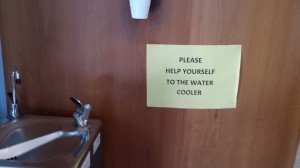I was reminded of the importance (and fascination, I kid you not) of textual design when by chance spotted a recent TED talk (I know I’ve been bagging them a bit lately, but …) from the engaging Matthew Carter: My life in typefaces.
If that has failed to engage you, don’t read on.
I was introduced to textual design back in 1981, when the Australian and South Pacific External Studies Association (ASPESA) invited Rob Waller (Robert H.W. Waller if you are searching the literature) from the UKOU to tour as an ASPESA Visiting Fellow. I found his talks inspirational – they opened up a whole world of which I was totally ignorant. His presentations were based on critical analysis of a series of examples, each of them vividly revealing how textual design radically influences the effectiveness of a written message, whether it be a lesson, instructions on a bottle of pills or a railway map. It also alerted me to the basics of textual design, serif versus sans serif fonts and so on.
Naturally I googled Robert H.W. Waller, and to my delight discovered that he has a website and accompanying blog (now added to the Links at the right). A bonus is the inclusion of downloadable copies of many of his publications, thereby allowing us to avoid paying the high fees charged by commercial publishers for individual chapters and articles. Within the blog, Waller continues his quest towards textual perfection, partly by revealing a litany of instances of poor (or downright misleading) textual communication (or miscommunication). Have a look at some amusing examples in his blog, ‘the simpleton‘.
The site also includes a list of his writings, most of which are downloadable (see also the technical papers page of the Simplification Centre). I can specifically highly recommend ‘Choosing a typeface for reading‘, especially if you’re new to the field. As well as a general discussion, it includes a checklist for such choice which provides responses to the questions:
Is there a good range of styles and weights?
Is there enough contrast between the weights?
Will it date quickly?
Is it still legible in small sizes?
Can you afford to risk any confusing characters?
Do you need any special characters or symbols?
Waller kickstarted me to follow a couple of other major contributors, James Hartley (from the UK) and David Jonassen (US). Jonassen recently rightly wrote, concerning his long pathway concerning education and educational technology:
“I began early on focusing on text design, culminating on the publications of two volumes of the Technology of Text. That work is still important because so much of the information on the World Wide Web (www) is in the form of text. Also, textbooks are still prominent. While it’s a topic that does not merit a lot of attention, it is still very relevant.” Contemporary Educational Technology, 2012, 3(1), 76-80
Jonassen edited two volumes of the Technology of Text, with Volume 1 my favourite. It’s a rich and varied source of eminently useable ideas and reminders … and good reading to boot. The chapter contributors were well chosen, covering a broad sweep of aspects of textual design. Rob Waller had chapters in both volumes, and you can access them via his website.
James Hartley, along-time contributor to the field of textual design, is probably best known for his ‘foundational’ book, Designing Instructional Text. Though quite old, it’s contents are still relevant and useful, as hinted by Jonassen’s quote above. It was certainly of great use to me as I sought to develop my skills in print-based distance education. If you’d like to read an example of his work, try ‘Designing instructional text for older readers: a literature review‘ (1994).
The message? Pay attention to textual design.
